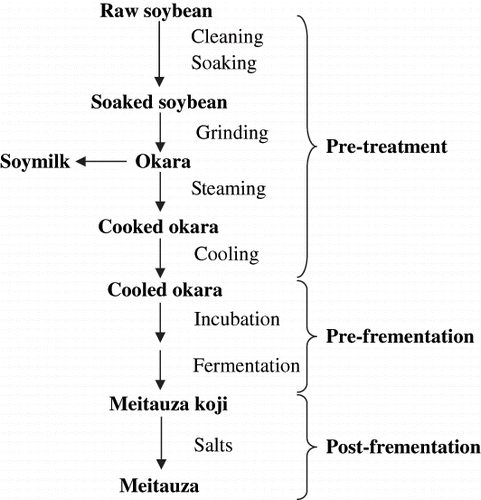Abstract
In order to investigate the antioxidative activity of Meitauza koji (Meitauza, a Chinese traditionally fermented okara), the okara was fermented with Aspergillus oryzae 3.951, Rhizopus oligosporus 3.912, Actinomucor elegans 3.118 and Bacillus subtilis B2 as kojis. All the methanol extract yields and peptide content of the kojis were higher than that of non-fermented okara. Moreover, the Meitauza kojis displayed enhanced antioxidative activities in comparison with the non-fermented okara. Among the four kinds of kojis tested, those fermented with B. subtilis B2 exhibited the highest levels of 2,2′-azinobis-3-ethylbenzothiazoline-6-sulfonic acid (ABTS) and 1,1-diphenyl-2-picrylhydrazyl (DPPH) radicals scavenging activities and reducing power. The ABTS and DPPH radicals scavenging activities of Meitauza koji fermented with B. subtilis B2 were ca. 12.53 and 7.92 folds that of the non-fermented okara. Analysis of the dose-response effect also revealed that before reaching a threshold point, there is a linear relationship between increases in antioxidative activity and increases in the concentration of koji extract. In addition, the peptide content of the Meitauza koji prepared with B. subtilis B2 increased from 8.6 mg to 34 mg per 100 mg extract. These results suggest the potential for developing traditional functional food with okara fermented by B. Subtilis B2.
INTRODUCTION
Free radicals generated by exogenous chemicals or endogenous metabolic processes in food systems or the human body may cause oxidative damage by oxidizing biomolecules and result in cell death and tissue damage.[Citation1] A number of pathological conditions including antherosclerosis, arthritis, diabetes and carcinogenesis have been correlated with free radicals.[Citation2,Citation3] However, ingestion of food-derived antioxidants may reduce free radicals and have a corresponding beneficial effect on human health.[Citation4,Citation5] Therefore, some traditional foods have aroused a great deal of attention mainly due to their various functionalities such as scavenging free radicals, anti-diabetic, antihypertensive and antithrombotic properties.[Citation6]
In the past few years, a great interest has been developed to study the health functional properties of traditionally fermented soybean foods such as miso, natto, tempeh, sufu, and douchi. It is proved that these traditional sobean foods possess many advantageous properties including free radical scavenging ability, reducing ability.[Citation7,Citation8,Citation9] Indeed, Meitauza, another traditional Chinese fermented food made from okara, is also widely consumed by Chinese people as a health food due to their high content of diary fiber. The manufacturing process of Meitauza (). is similar to that of Chinese douchi except the different raw materials. Previously, Kronenber and Hang[Citation10,Citation11] have reported the production of Meitauza using Actinomucor elegans by solid-state fermentation. Matsuo[Citation12] also reported the preparation and components of okara-ontjom (a traditional Indonesian fermented food, which is similar to Chinese Meitauza). However, these reports just investigated the production condition of Meitauza or okara-ontjom, while few reports about the functional properties of Meitauza have been involved.
Generally, the traditional soybean foods are usually fermented by Bacillus, Aspergillus, Rhizopus and Mucor strains respectively or mixed culture fermentation.[Citation7,Citation8,Citation13] The proteolysis of soybean proteins during fermentation can enhance the nutritional value, retard spoilage, improve the solubility and taste, and remove undesirable flavors.[Citation13,Citation14] Especially some low-molecular-weight compounds such as peptides and free amino acids possessing antioxidative activities against free radicals may be achieved by proteolysis during fermentation.
In an attempt to investigate the effect of microorganism on the antioxidative activity of Meitauza, this study was performed to prepare the Meitauza koji with the four typical organisms that are traditionally used in the preparation of many soybean fermented foods. Moreover, the DPPH radical scavenging effect, ABTS radical scavenging effect and reducing power of the methanol extracts of koji fermented with different starter organisms were examined and compared. Besides, the change of peptide content of the Meitauza koji was also investigated.
MATERIALS AND METHODS
Microorganism
In this study, test organisms including Aspergillus oryzae 3.951, Rhizopus oligosporus 3.912, Actinomucor elegans 3.118 were obtained from the Institute of Microbiology, Chinese Academy of Sciences (Beijing, China). Bacillus subtilis B2 was isolated from Hubei (a province located in middle of China) Meitauza. All these test organisms are commonly used as starter organisms for the preparation of traditionally oriental fermented food products such as meitauza, douchi, sufu, miso, soy sauce, and others.
Before experiment, A. oryzae 3.951, R. oligosporus 3.912 and A. elegans 3.118 were activated by two successive transfers to potato dextrose agar (PDA, Difco, Detroit, Michigan, USA) slants and incubated at 30°C for 3 days. Then the activated culture was inoculated into PDA and incubated at 30°C for 3 days. Spores of the organism were harvested by flooding the surface of the agar with sterile distilled water containing 0.1% tween 80. The spore suspension was adjusted with sterile distilled water to a concentration of ca. 106/mL and served as inocula culture for the fermentation of okara. B. subtilis B2 was inoculated into luria-Bertani medium (Oxoid) and incubated for 16 h at 40°C. The culture was diluted in sterile distilled water with 0.9% NaCl and 0.1% peptone to approximately 106 colony forming units (cfu)/mL and served as inocula culture for the fermentation of okara.
Materials
The okara used for fermentation was provided by Beijing WangZhiHe sufu manufacture. Proximate analysis of the okara revealed that it contained approximately 85 kg/100 kg sample moisture, 3.65 kg/100 kg sample crude protein, 1.37 kg/100 kg sample crude lipid, 9.22 kg/100 kg sample of crude fiber and 0.76 kg/100 kg sample others). 1,1-diphenyl-2-picrylhydrazyl (DPPH), 2,2′-azinobis-3-ethylbenzothiazoline-6-sulfonic acid (ABTS), were purchased from Sigma Chemical Co. (St. Louis, MO, USA). The other reagents were of analytical grade.
Preparation of Meitauza Koji
The fresh okara containing 85% of water was autoclaved at 121°C for 30 min, and then cooled and inoculated with 1% (v/w) of the fresh okara. After mixing, aliquots (200 g) of the inoculated okara were placed in bamboo baskets (11 cm in diameter, 4 cm in depth) covered with wet cheesecloth. The okara inoculated B. subtilis B2 incubated at 40°C for 48 h in an incubator with relative humidity at around 95% (LTI-601 SD, Tokyo Rikakikai Co., Ltd, Tokyo, Japan). The other okara respectively inoculated A. oryzae, R. oligosporus and A. elegans were incubated at 30°C for 60 h in an incubator with relative humidity at around 90% (LTI-601 SD, Tokyo Rikakikai Co., Ltd, Tokyo, Japan). Samples were obtained and immediately dried by freeze dryer lyophilization (FDU-54, Tokyo Rikakikai Co., Ltd, Tokyo, Japan) for further analysis.
Methanol Extraction of Meitauza Koji
One g of Meitauza koji was added 20 mL of methanol and homogenized for 2 min (T25BS4, IKA Labortechnik, Staufen, Germany). The homoginized sample was kept at 60°C for 1 h in the water bath shaker (150 rpm). After centrifugation (3000 × g, 15 min), the corresponding supernatant was filtered under vacuum with 0.45-μm membrane (Millex-HX, Millipore, Yonezawa, Japan) and the filtrate was used as the methanol extract of Meitauza koji for further analysis.
Determination of ABTS Radical Scavenging Activity
The experiments were carried out using an improved ABTS decolorisation assay[Citation15] and it involves the generation of ABTS radical chromophore by the oxidation of ABTS with potassium persulfate. It is applicable for both hydrophilic and lipophilic compounds. The ABTS radical cation was produced by reacting 7 mM stock solution of ABTS with 2.45 mM potassium persulfate (final concentration) and allowing the mixture to stand in the dark for at least 12 h at room temperature before use. The ABTS radical solution was diluted to an absorbance of 0.75 ± 0.05 at 734 nm (UVmini-1240 spectrophotometer, Shimazu; Japan). Absorbance was measured 6 min after the initial mixing of different samples with ABTS radical solution. The ABTS radical scavenging activity was determined as follows:
Determination of DPPH Radical Scavenging Activity
The effect of methanol extract of Meitauza koji on the DPPH radical was estimated according to the modified method of Suda.[Citation16] An aliquot (0.1 mL) of the DPPH radical solution (0.25 mM, in methanol) and 0.1 mL of the sample were added to the microplate and then the mixture was shaken vigorously using microplate mixer for 20 min in the dark. The decrease in absorbance was measured at 520 nm against a blank (without sample) (550 microplate reader, Bio-Rad Laboratories, Japan). The DPPH radical scavenging activity was determined as follows:
Determination of Reducing Power
The reducing power of the methanol extracts of Meitauza kojis was measured according to the method of Oyaizu.[Citation17] 0.5 mL of the sample was mixed with 2.5 mL of phosphate buffer (0.2 M, pH 6.6) and 2.5 mL of potassium ferricyanide (1%), and then the mixture was incubated at 50°C for 20 min. After 2.5 mL of TCA (10%) was added, the mixture was centrifuged (3000 × g, 10 min). The corresponding supernatant (2.5 mL) was mixed with 2.5 mL of distilled water and 0.5 mL of ferric chloride and the absorbance was measured at 700 nm with a spectrophometer (UVmini-1240 spectrophotometer, Shimazu, Japan). Higher absorbance of the reaction mixture indicated greater reducing power.
Determination of Peptide Content
The peptide was determined according to the o-phthaldialdehyde method.[Citation18] 50 μl of samples were added to 2 mL OPA mixture (50 mL of a mixture containing 25 mL of 100 mM sodium tetraborate, 2.5 mL of 20% [w/w] sodium dodecyl sulfate, 40 mg of o-phthaldialdehyde dissolve in 1 mL methanol, 100 μl of β-mercaptoethanol, and 21.4 mL distilled water). After 20 min incubation at room temperature, the absorbance at 340 nm was measured. The peptide was calculated on the basis of the standard curve constructed by using L-Glutathione(Reduced Form) as standard.
Statistical Analysis
All tests and analyses were run in triplicate and the average and standard deviation values are presented. Correlation analysis and its significance were carried out using SAS (Version 8.0; SAS Inst., Cary, N.C., U.S.A.).
RESULTS AND DISCUSSION
Methanol Extract Yield of Various Meitauza Koji
The non-fermented okara was found to contain a methanol extract yield of 3.14% (). Yields of methanol extract in the Meitauza kojis ranged from 5.35% to 13.03% and also varied with the starter organism. The A. oryzae Meitauza koji showed the highest concentration yield of methanol extract while the A. elegans Meitauza koji showed the lowest yield of methanol extract among the various kojis examined.
Table 1 Methanol extract yield of various Meitauza kojis (%)
ABTS Radical Scavenging Activity
shows the dose-response curve for the ABTS radical-scavenging activity of the methanol extract of various koji samples. In general, at a dosage of 0.5 mg/mL or less, regardless of the starter organism employed for fermentation, the ABTS radical-scavenging effect increased as the concentration of the Meitauza koji extract was increased. Further increase of the dosage did not significantly increase the ABTS radical-scavenging effect. The prepared methanol extract of Meitauza kojis, at a dosage of 0.5 mg/mL showed various degrees of sacvenging effect for ABTS radicals (83.2–96.5%) depending on the starter organism. In comparison, the control (non-fermented steamed okara extract) showed a scavenging effect of 63.9% for ABTS radical.
Figure 2 ABTS radical scavenging activity of various extracts of Meitauza koji. Values represent the means + standard deviation (SD) of n = 3 duplicate assays.
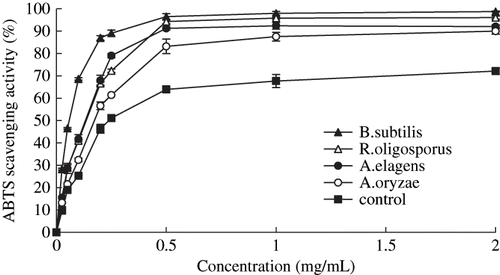
The half-inhibition concentration (IC50), which is the efficient concentration required to decrease initial ABTS concentration by 50% of various koji extracts is shown in . The IC50 values were obtained by interpolation from linear regression analysis of data shown in . It was noted that IC50 of all koji extracts was significantly lower than that of the non-fermented okara extract. Among all the okara extracts tested in the present study, the methanol extract of koji prepared with B. subtilis B2, with an IC50 of 0.058 mg/mL, exhibited the highest scavenging effect, which is about 4.3 folds that of the non-fermented-okara extract for ABTS radicals. Since the content of methanol extract varies with the okara samples tested, the relative scavenging effect exerted by okara samples, taking into account the extract content, are calculated and also displayed in . The relative scavenging effect of okara samples was calculated by dividing the methanol extract content of Meitauza koji with the IC50 of the respective extract, and then compared with the scavenging effect of non-fermented steamed okara. As shown in , the Meitauza koji preparation exhibited an enhanced ABTS radical-scavenging effect compared with the non-fermented okara. The Meitauza koji showed a relative ABTS radical scavenging effect from 3.46 to 12.53 compared with that of the non-fermented okara, which was assigned as 1.0. Among them, the B. subtilis B2 Meitauza koji exhibited the highest ABTS scavenging effect, at a level approximately 13 folds that exhibited by the non-fermented steamed okara.
Table 2 IC50 of Meitauza koji extracts and relative antioxidative effects of Meitauza kojis in ABTS and DPPH radical scavenging activities
DPPH Radical Scavenging Activity
The DPPH radical is another source of free radical for evaluating the antioxidative ability. As shown in , all the methanol extracts tested exhibited DPPH radical scavenging activity. The DPPH radical scavenging activity of all the extracts increased as their concentration increased up to 5 mg/mL. At this dosage level, the methanol extract, regardless of their source, exhibited DPPH radical scavenging activity of 89% or more. In addition, extracts of all Meitauza koji showed a higher DPPH radical scavenging activity than that of non-fermented steamed okara. This phenomenon of increased DPPH radical scavenging activity is in accordance with that observed on douchi, sufu, miso, and temph.[Citation7,Citation19,Citation20]
Figure 3 DPPH radical scavenging activity of various extracts of Meitauza koji. Values represent the means + standard deviation (SD) of n = 3 duplicate assays.
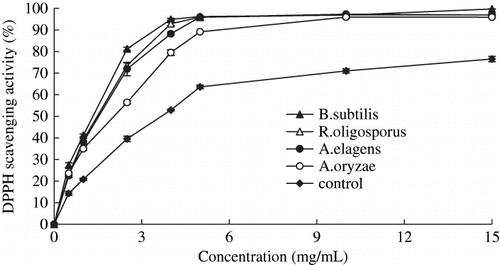
As shown in , the methanol extracts of non-fermented okara and Meitauza koji showed an IC50 ranging between 1.34 and 3.62 mg/mL. It was noted that IC50 of all koji extracts was lower than that of the non-fermented okara extract. The Meitauza koji fermented with B. Subtilis B2 showed the lowest IC50 value of 1.34 mg/mL. Similar results were previously reported for the enhanced DPPH radical scavenging activity after fermentation.[Citation21] For example, the DPPH radical scavenging activity of soybean can be enhanced through fermentation with Asp. awamori and the IC50 value of the soybean koji was increased to 2.4 mg/mL, which was higher than that of the non-fermented soybean.[Citation21] Compared with the soybean koji, in our case, the Meitauza koji fermented with B. Subtilis B2 exhibited a lower IC50 value, i.e. a higher free radical scavenging ability.
A higher relative DPPH radical scavenging activity was observed with the prepared Meitauza koji than the non-fermented okara when the initial methanol extract content was taken into account. The relative DPPH radical scavenging activity of okara increased by 3.25–7.92 folds after fermentation, depending on starter organism employed.
Although some reports about Meitaza have been reported previously, few of them involved the free radical scavenging activity of Meitauza.[Citation10,Citation11,Citation12] Based on above experimental data, it could be concluded that the okara after fermentation exhibit strong activity of scavenging ABTS and DPPH radicals. In addition, the free radical scavenging activity of certain Meitauza koji is even stronger than the soybean koji which is usually considered as a kind of functional food. This is an interesting finding because Meitauz may become another new functional food by using okara, a cheaper by-product of soybean industry.
Reducing Power
In this study, assay of reducing power was based on the reduction of Fe3+/ferricyanide complex to the ferrous form in presence of reductants (antioxidants) in the tested samples. The Fe2+ was then monitored by measuring the formation of Perl's Prussian blue at 700 nm.[Citation17] The dose-response curves for reducing power of various Meitauza koji extracts and the non-fermented okara extract (control) is shown in . Generally, it was found that the reducing power increased as concentration of the tested samples increased to a certain extent, and then leveled off despite further increases in concentration. For instance, at the concentration of 20 mg/mL, extract of B. Subtilis B2 Meitauza koji showed an absorbance of 1.74 at 700 nm, but the absorbance did not significantly increase with the concentration further. All the extracts of Meitauza kojis showed a higher absorbance than the non-fermented okara extract at the same dosage level.
Figure 4 Reducing power of various extracts of Meitauza koji. Values represent the means + standard deviation (SD) of n = 3 duplicate assays.
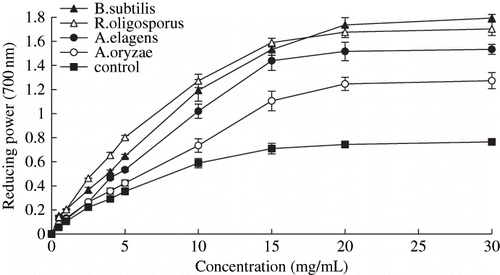
Similar findings of the enhanced reducing power of fermented soybean and soybean products have been previously reported.[Citation9,Citation13,Citation21,Citation22] The formation of reductants that could react with free radicals to stabilize and terminate radical chain reactions during fermentation may contribute to the increased reducing power. Some antioxidant peptides from the enzymatic hydrolysates of isolated soybean protein (β-conglycinin) and okara protein[Citation23] and some amino acids, such as lysine, glycine, valine, and histidine, have also been reported to show antioxidant activity.[Citation24,Citation25] Moreover, the increased reducing power may also due to the intracellular antioxidants, peptides of the starter organism and their hydrogen-donating ability.[Citation26]
Peptide Content
Many active peptides can chelate iron, scavenge the free radicals, and inhibit the formation of peroxides, which can consequently prevent the peroxidation of lipids.[Citation13,Citation26] In our study, the peptide in Meitauza koji was increased after fermentation with different micrioorganism. Changes of peptide content of the methanol extract of Meitauza koji is shown in . The Meitauza koji prepared with different organism exhibited higher peptide content compared with that of non-fermented okara. The peptide content of the non-fermented okara was 8.6 mg per 100 mg extract while the Meitauza koji prepared with R. oligosporus and A. elegans increased to 17.9 mg and 16.9 mg per 100 mg extract, which was about 2 folds compared with that of non-fermented okara. Among the Meitauza koji fermented with different microorganism, the koji made from B. subtilis B2 showed the highest peptide content of 34 mg per 100 mg extract, at a level of 4 folds that exhibited by the non-fermented okara. In fact, B. subtilis B2 exhibited much higher protease activity than A. oryzae, R. oligosporus and A. elegans during okara fermentation (data not shown). The high proteinase activity of B. subtilis B2 may play an important role in degrading okara protein and many low-molecular-weight compounds such as peptides could be achieved by soy protein hydrolysis.[Citation27]
Figure 5 Change of peptide content of various extracts of Meitauza koji. Values represent the means + standard deviation (SD) of n = 3 duplicate assays.
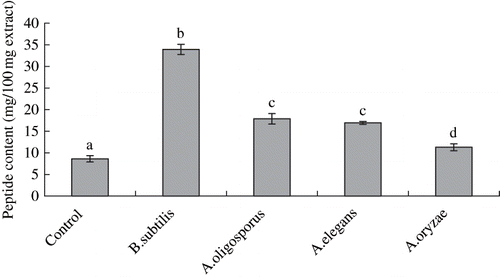
Combined with the antioxidative activity of these Meitauza koji, the peptide content of Meitauza koji extracts are significantly correlated with the DPPH scavenging ability, ABTS scavenging ability, reducing power (P < 0.05). The higher antioxidative activities observed with the Meitauza koji extracts could thus relate to their high peptide. This phenominon is in accordance with the previous report of Yin and Wang.[Citation13,Citation28] They also observed that the peptide increased during the fermentation of minced mackerel and soymilk with lactic acid bacterial and thus lead to the increased antioxidative activity of the fermented minced mackerel and soymilk. In addition, some phennolic compounds and some amino acids, such as lysine, glycine, valine, and histidine, which have been reported to show antioxidant activity,[Citation29,Citation30] could be present in the Meitauza koji. Moreover, the increased antioxidant activity may also due to the intracellular antioxidants, peptides of the starter organism and their hydrogen-donating ability.[Citation22] In our study, the extract of Meitauza koji prepared with B. subtilis B2 exhibited high antioxidative activity and peptide content, which indicate a great potential to produce functional food using B. subtilis B2.
CONCLUSION
Based on the findings obtained from the present study, it can be concluded that an enhanced methanol extract yield, ABTS, DPPH radical scavenging activities, reducing power, and higher peptide of the Meitauza kojis can be obtained through fermentation with various microorganism. The higher antioxidative activities observed with the Meitauza koji extracts could thus relate to their increased peptide content (P < 0.05). Moreover, the Meitauza koji fermented with B. subtilis B2 exhibited the highest levels of ABTS and DPPH radicals scavenging activities with ca. 12.53 and 7.92 folds that of the non-fermented okara and the highest level of reducing power. These results have suggested the potential for developing traditional functional Meitauza with okara fermented by B. Subtilis B2 for its higher antioxidative ability.
ACKNOWLEDGEMENTS
This study was conducted within the framework of the collaborative research project between Japan and China entitled, “Development of sustainable production and utilization of major food resources in China,” supported by Japan International Research Center for Agricultural Sciences (JIRCAS). This work was also supported by fund of the National Key Technologies R&D program (2006BAD27B09) of the 11th 5-year plan of the People's Republic of China.
Notes
aThese authors Contributed equally to this work.
REFERENCES
- Kehrer , J.P. 1993 . Free radicals as mediators of tissue injury and disease . Critical Reviews in Toxicol , 23 : 21 – 48 .
- Halliwell , B. 1994 . Free radicals, antioxidants, and human disease: curiosity, cause, or consequence . Lancet , 344 : 721 – 724 .
- Halliwell , B. , Aeschbach , R. , Loliger , J. and Aruoma , O.I. 1995 . The characterization of antioxidants . Food and Chemical Toxicology , 33 : 601 – 617 .
- Antonio , C. and Marino , B.A. 2005 . Hydrophilic and lipophilic antioxidant activity in different leaves of three lettuce varieties . International Journal of Food Properties , 8 ( 3 ) : 521 – 528 .
- Nagai , T. , Nagashima , T. , Abe , A. and Suzuki , N. 2006 . Antioxidative activities and angiotensin I-Converting enzyme inhibition of extracts prepared from chum salmon (Oncorhynchus Keta) cartilage and skin . International Journal of Food Properties , 9 ( 4 ) : 813 – 822 .
- Sidhu , J.S. , Kabir , Y. and Huffman , F.G. 2007 . Functional foods from cereal grains . International Journal of Food Properties , 10 ( 2 ) : 231 – 244 .
- Santiago , L.A. , Hiramatsu , M. and Mori , A. 1992 . Japanese soybean paste miso scavenges free radicals and inhibits lipid peroxidation . Journal of Nutritional Science and Vitaminology , 38 : 297 – 304 .
- Berghofer , E. , Grzeskowiad , B. , Mundigler , N. , Sentall , W.B. and Walcak , J. 1998 . Antioxidative properties of faba bean-, soybean-, soybean-, and oat tempeh . International Journal of Food Sciences and Nutrition , 49 : 45 – 54 .
- Chung , Y.C. , Chang , C.T. , Chao , W.W. , Lin , C.F. and Chou , S.T. 2002 . Antioxidative activity and safety of the 50% ethanolic extract from red bean fermented by Bacillus subtilis IMR-NK1. . Journal of Agricultural and Food Chemistry , 50 : 2454 – 2458 .
- Kronenberg , H.J. and Hang , Y.D. 1984 . Biochemical changes in okara during meitauza fermentation . Nutrition Report International , 30 : 439 – 443 . Food Science and Technology Abstract 85-03-G0002.
- Kronenberg , H.J. and Hang , Y.D. 1985 . A puncture testing method for monitoring solid substrate fermentation . Journal of Food Science , 50 : 539 – 540 .
- Matsuo , M. 1997 . Preparation and components of okara-ontjom, a traditional Indonesian fermented food . Nippon Shokuhin Kagaku Kogaku Kaishi , 44 : 632 – 639 . Chemisty Abstract 127, 277461.
- Wang , Y.C. , Yu , R.C. and Chou , C.C. 2006 . Antioxidative activities of soymilk fermented with lactic acid bacteria and bifidobacteria . Food Microbiology , 23 : 128 – 135 .
- Fan , J.F. , Saito , M. , Zhang , Y.Y. , Tan , S.S. , Wang , L.J. , Tatsumi , E. and Li , L.T. 2005 . Gel-forming ability and radical-scavenging activity of soy protein hydrolysate treated with transglutaminase . Jouranl of Food Science , 70 : 87 – 92 .
- Re , R. , Pellegrini , N. , Proteggente , A. , Pannala , A. , Yang , M. and Rice Evans , C. 1999 . Antioxidant activity applying an improved ABTS radical cation decolorisation assay . Free Radical Biology and Medicine , 26 : 1231 – 1237 .
- Suda , I. 2000 . The methods of food functions analysis in antioxidative activity Edited by: Shinohara , K. , Suzuki , T. and Kaminogaw , S. 218 – 220 . Korin, , Japan
- Oyaizu , M. 1986 . Antioxidative activities of browning reaction prepared from glucosamine . Japanese Journal of Nutrition , 44 : 307 – 315 .
- Church , F.C. , Swaisgood , H.E. , Porter , D.H. and Catignani , G.L. 1983 . Spectrophotometric assay using o-phthaldialdehyde for determination of proteolysis in milk and isolated milk proteins . Jouranl of Dairy Science , 66 : 1219 – 1227 .
- Wang , L.J. , Saito , M. , Tatsumi , E. and Li , L.T. 2003 . Anti-oxidative and angiotensin I-Converting enzyme inhibitory activity of sufu (fermented tofu) extracts . Japanese Agricultural Research Quarterly , 37 : 129 – 132 .
- Wang , L.J. , Dong , L. , Zou , L. , Chen , X.D. , Cheng , Y.Q. , Yamaki , K. and Li , L.T. 2007 . Antioxidative activity of douchi (a Chinese traditional salt-fermented soybean food) extracts during its processing . International Journal of Food Properties , 10 ( 2 ) : 385 – 396 .
- Lin , C.H. , Wei , Y.T. and Chou , C.C. 2006 . Enhanced antioxidative activity of soybean koji prepared with various filamentous fungi . Food Microbiology , 23 : 628 – 633 .
- Yang , J.H. , Mau , J.L. , Ko , P.T. and Huang , L.C. 2000 . Antioxidant properties of fermented soybean broth . Food Chemistry , 71 : 249 – 254 .
- Yokomizo , A. , Takenaka , Y. and Takenaka , T. 2002 . Antioxidative activity of peptides prepared from okara protein . Food Science and Technology Research , 8 : 357 – 359 .
- Marcuse , R. 1960 . Antioxidative effect of amino acids . Nature , 186 : 886 – 887 .
- Wade , A.M. and Tucker , H.N. 1998 . Antioxidant characteristics of L-histidine . Journal of Nutritional Biochemisty , 9 : 308 – 315 .
- Rajapakse , N. , Mendis , E. , Jung , W.K. , Je , J.Y. and Kim , S.K. 2006 . Purification of a radical scavenging peptide from fermented mussel sauce and its antioxidant properties . Food Research International , 38 : 175 – 182 .
- Zhu , Y.P. , Fan , J.F. , Cheng , Y.Q. and Li , L.T. 2008 . Improvement of the antioxidant activity of Chinese traditional fermented okara (meitauza) using bacillus subtilis B2 . Food Control , 19 : 654 – 661 .
- Yin , L.J. , Tong , Y.L. and Jiang , S.T. 2005 . Improvement of the functionality of minced mackerel by hydrolysis and subsequent lactic acid bacterial fermentation . Journal of Food Science , 70 ( 3 ) : 172 – 178 .
- Strazzullo , G. , De Giulio , A. , Tommonaro , G. , La Pastina , C. , Poli , A. , Nicolaus , B. , De Prisco , R. and Saturnino , C. 2007 . Antioxidative activity and lycopene and β-carotene contents in different cultivars of tomato (Lycopersicon Esculentum). . International Journal of Food Properties , 10 ( 2 ) : 321 – 329 .
- Wade , A.M. and Tucker , H.N. 1998 . Antioxidant characteristics of L-histidine . Journal of Nutritional Biochemistry , 9 : 308 – 315 .
